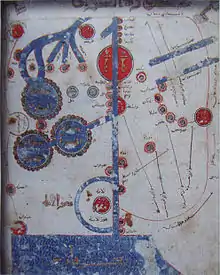Istakhri
Abu Ishaq Ibrahim ibn Muhammad al-Farisi al-Istakhri (آبو إسحاق إبراهيم بن محمد الفارسي الإصطخري) (also Estakhri, Persian: استخری, i.e. from the Iranian city of Istakhr, b. - d. 957 AD [346AH][2]) was a 10th-century travel-author and geographer who wrote valuable accounts in Arabic of the many Muslim territories he visited during the Abbasid era of the Islamic Golden Age. There is no consensus regarding his origin. Some sources describe him as Persian,[1] while others state he was Arab.[3] The Encyclopedia of Islam, Second Edition states that his "biography is unknown, or almost so".[4] The Encyclopedia Iranica states: "Biographical data are very meager. From his nesbas (attributive names) he appears to have been a native of Eṣṭaḵr in Fārs, but it is not known whether he was Persian".[5]
Abū Ishāk al-Fārisī al-Iṣṭakhrī | |
|---|---|
| Born | |
| Died | died after 952[1] |
| Academic background | |
| Influences | Al-Balkhi |
| Academic work | |
| Era | Islamic Golden Age |
| School or tradition | Balkhi school |
| Main interests | Islamic geography |



Istakhri's account of windmills is the earliest known. Istakhri met the celebrated traveller-geographer Ibn Haukul, while travelling in the Indus Valley.[6] and Haukul's magnum opus, Kitab al-Surat al-Ard, incorporated the work of Istakhri.
Works
Istakhri's two surviving works are:
- Masālik al-Mamālik (مسالك الممالك, "Routes of the Realms")
- Ṣuwar al-ʿAqālīm ( صور الاقاليم, "Pictures of the Regions")
Published Editions
An 8-volume edition of works by medieval Arab geographers, edited by the Dutch orientalist Michael Jan de Goeje in a series titled Bibliotheca geographorum Arabicorum was published by Brill, Lugduni-Batavora (Leiden) in the 1870s. An edition of Istakhri's MS text was produced for the first volume under the Latin title Viae Regnorum descriptio ditionis Moslemicae - "Description of Roads of the Kingdoms in Muslim territories". In 1927 the editor Theodore Noldeke produced a second edition.
In 1845 the German orientalist A. D. Mordtmann published a translation in Hamburg with the title Das Buch der Länder von Schech Ebu Ishak el Farsi el Isztachri, with a foreword by C. Ritter. (Schriften der Akademie von Ham Bd. 1, Abth. 2).
See also
- Ibn Hawqal
- Al-Maqdisi
- Ibn al-Faqih
- Qudama ibn Ja'far
- Ibn Khordadbeh
- Ibn Rustah
- Al-Ya'qubi
- Al-Masudi
- List of Iranian scientists
References
- Shboul, Ahmad M. H. (1991). "Iṣṭakhrī, al-". In Kazhdan, Alexander (ed.). The Oxford Dictionary of Byzantium. Oxford and New York: Oxford University Press. ISBN 0-19-504652-8.CS1 maint: ref=harv (link)
- Mojtahed-Zadeh, Pirous. "The Persian Gulf in the Geographical Views of the Ancient World" In Cartographie Historique du Golfe Persique. Edited by M. Taleghani, D. Silva Couto, & J.-L. Bacque-Grammont. Louvain, Belgium: Diffusion, 2006. 17.
- van Donzel, E.J., ed. (1994). Islamic Desk Reference (compiled from the Encyclopedia of Islam). Brill. p. 177. ISBN 978-9004097384.
- Miquel, A. (2012). "al-Iṣṭak̲h̲rī". In P. Bearman; Th. Bianquis; C.E. Bosworth; E. van Donzel; W.P. Heinrichs (eds.). The Encyclopedia of Islam, Second Edition. BRILL Online.
- Bolshakov 1998, pp. 646-647.
Sources
- Bolshakov, O. G. (1998). "EṢṬAḴRĪ, ABŪ ESḤĀQ EBRĀHĪM". Encyclopaedia Iranica, Vol. VIII, Fasc. 6. pp. 646–647.
- Bosworth, Clifford Edmund (1989). "al-Masālik wa'l-Mamālik". The Encyclopedia of Islam, Volume 6. Leiden: E. J. Brill. pp. 639-640.
- de Goeje, M.J., ed. (1927). Bibliotheca Geographorum Arabicorum (1927), vol 1: Viae Regnorum descriptio ditionis Moslemicae auctore Abu Ishák al-Fárisí al-Istakhrí (in Arabic). Leden: E. J. Brill.
- Ouseley, William, ed. (1800). The oriental geography of Ebn Haukal, an Arabian traveller of the tenth century. London. - Note: in fact, it is a work by Istakhri
- Al-Istakhri, Abu Ishaq Ibrahim ibn Muhammad (1927), Goeje, M. J. de; Noldeke, Theodore (eds.), "Viae Regnorum descriptio ditionis Moslemicae auctore Abū Ishāk al-Fārisi al-Istakhri", Bibliotheca geographorum Arabicorum (in Arabic and Latin) (2 ed.), Lugdunum Batavorum (Leiden): Brill publishers, 1
- Ibn Haukal (1873), Goeje, M. J. de (ed.), "Viae et regna, descriptio ditionis moslemicae auctore Abu'l-Kasim Ibn Haukal", Bibliotheca geographorum Arabicorum (in Arabic and Latin), Lugdunum Batavorum (Leiden): Brill publishers, 2
- Goeje, M. J. de, ed. (1870), "Indices, glossarium et addenda et emendanda ad Part I-III", Bibliotheca geographorum Arabicorum (in Arabic and Latin), Lugdunum Batavorum (Leiden): Brill, 4
- Das Buch der Länder von Schech Ebu Ishak el Farsi el Isztachri, translated by Mordtmann, Andreas David, Frankfurt/M.: Rauhen Hauses in Horn, 1995 [1845]
